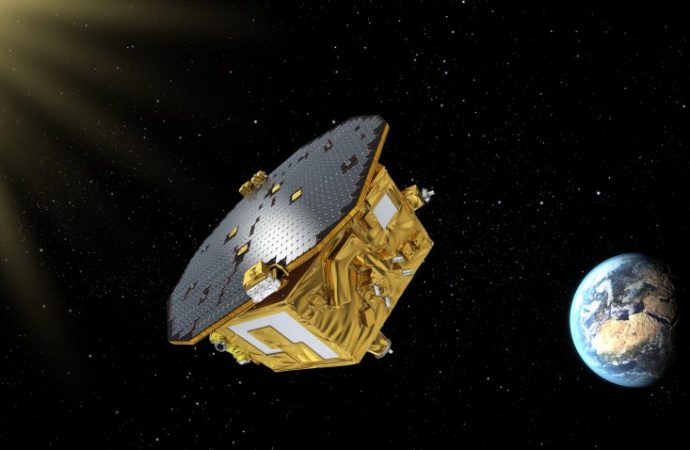Job done. LISA Pathfinder, the European mission launched to see whether it would be possible to build a gravitational wave detector in space, has reported back that the answer is a resounding yes.
Mission operators say that the results obtained thus far from 55 days of measuring distances between two free-floating metal cubes in an orbiting spacecraft support the construction of a full-scale space detector using the same technology, which would be able to observe the catastrophic merger of supermassive black holes far across the universe and other cataclysmic events. That mission—the proposed €1 billion Evolved Laser Interferometer Space Antenna (eLISA)—is not yet formally approved or scheduled to take place until 2034, however.
Gravitational wave detectors are more like microphones than telescopes and “allow us to listen to the universe,” Fabio Favata of the European Space Agency’s (ESA’s) science directorate told a press conference in Madrid today at which LISA Pathfinder’s first results were unveiled. But with ground-based detectors being 4 kilometers across and eLISA’s multiple spacecraft shooting lasers to each other across as much as 5 million kilometers of space, there is much technology development to do. “We have to learn to walk before we learn to run,” Favata says.
Hence the launch of LISA Pathfinder. The eLISA mission would listen for gravitational waves by having three spacecraft flying in formation millions of kilometers apart and firing laser beams between them to measure the distances. If a gravitational wave passes by, it will compress and stretch space, causing those distances to change. The changes will be tiny, in the range of a millionth of a millionth of a meter, so the measurement systems have to be highly precise.
The key to the system is free-floating “test masses,” small cubes of a gold-platinum alloy about the size of golf balls, which act as end-mirrors for the laser beams. The masses have to float free of any external forces, so only gravity is acting on them, and the lasers, with the help of an optical instrument called an interferometer, measure the distance between the test mass in one spacecraft and its twin in another craft a long way away. The role of each spacecraft is, in addition to making these measurements, protecting the masses from external forces such as sunlight and solar wind.
To show that the necessary sensitivity is possible, LISA Pathfinder measures the distance between two masses, both of which are inside the spacecraft. “We’ve shrunk the arm of a large gravitational wave antenna to 35 centimeters so we could show it works properly,” Paul McNamara, LISA Pathfinder project scientist, told the press conference.
LISA Pathfinder was launched in December 2015 to a spot 1.5 million kilometers from Earth. When its test masses where first released to float free in February, “the relief was unbelievable,” McNamara says. Science operations began on 1 March and on that first day the team was able to measure distance variations between the masses much smaller than LISA Pathfinder’s mission requirements, Stefano Vitale, the mission’s principle investigator, told reporters. After a month, the variations were even smaller, “very close to [eLISA] requirements,” he says.
The team report their results in a paper published today in Physical Review Letters. Much of the residual tiny movements of the two masses are due to the few gas molecules left in the spacecraft banging against them. As those continue to be pumped out that “thermal noise” is further reduced. Vitale says today the mission is meeting eLISA requirements: The amount of acceleration measured between the two masses was measured as less than a tenth of a femto-g—that’s a tenth of a millionth of a billionth of Earth’s gravity.
The very first detection of a gravitational wave by a ground-based detector, the Laser Interferometer Gravitational Observatory (LIGO), was only made earlier this year after decades of trying. Vitale said that there are two key requirements for eLISA to go ahead: a successful LISA Pathfinder and detecting gravitational waves. “It’s been an annus mirabilis to get both at once,” he says.
Once eLISA is in operation—in 2034 or possibly sooner—McNamara says it will provide “a whole new way to see the universe. We can build up a history of the universe and understand why it is like it is today.” But, he says, just as LIGO’s discovery provided unexpected results, “it’s the things we don’t know yet that really get us excited.” Vitale says he is looking forward to studying the situation when a small black hole spirals down into a supermassive one. “It follows a very complicated orbit and will send a message: mapping the gravitational field of the [supermassive] black hole. It will tell us, does the event horizon really exist. Wow!”
Source: Science Mag

































Leave a Comment
You must be logged in to post a comment.